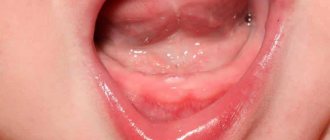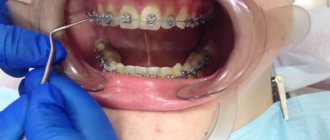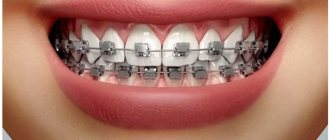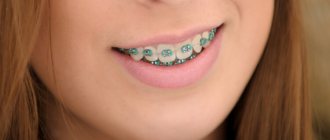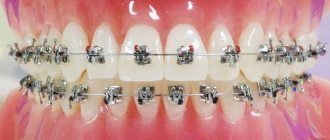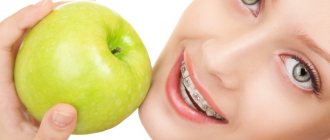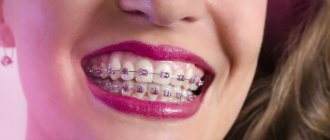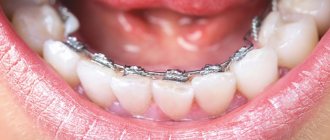3331
When creating bracket systems, various materials and their combinations are used - metal, plastic, polymers (ceramic, sapphire).
Unfortunately, it is metal staples that most often cause a hypersensitivity reaction (allergy).
Allergies to braces today are a common occurrence that can occur in people who are sensitive to these metals.
Can you be allergic to braces?
And you can be allergic to braces, as well as to any other external intrusion into the body. It occurs as a result of a special state of the immune system, its excessive reaction and the desire to get rid of a foreign object - an allergen.
In this case, the allergen is the materials from which the braces are made.
Interesting!
The body can react differently to the same metal alloys, but from different manufacturers. Reactions occur most often in people prone to allergies.
Braces and allergies
Modern brace systems are made from various materials and alloys. Artificial sapphires, composite materials, ceramics and various metal alloys. According to the manufacturers, they are hypoallergenic and do not cause allergies.
In fact, statistics show that up to 20% of people experience allergic symptoms to certain components of the braces system containing nickel and up to 10% to the latex parts of braces (tractions, chains, ligatures).
Plastic and metal alloys in budget bracket systems can also cause allergies.
Most often, an allergy to braces is unnoticeable and the patient cannot draw a clear relationship between correcting the bite with braces and allergic symptoms.
The most common manifestations of a reaction to the components of the brace system are minor rashes at the points of contact between the system and the mucous membrane, runny nose, dizziness, difficulty breathing, ulcers and swelling. Swelling of the larynx, hearing problems, general swelling - can also be signs of allergies.
It is worth paying attention not only to the oral cavity. In rare cases, hives or eczema may appear throughout the body. Indigestion, low blood pressure, lacrimation and, as a result, conjunctivitis.
But it's not all that scary. Firstly, the percentage of people suffering from allergies to braces is still significantly less than healthy ones. Secondly, people suffering from allergies of any origin need to inform their doctor about this and take allergy tests for the components of braces, primarily for nickel and latex. And in case of positive tests, choose another system, without allergens.
Allergy tests
On the Internet, you can often find a simple way to determine an allergy to braces - tie a bandage to your wrist with a piece of an arch and a brace lock. If you have an allergy, your body will react to the test. This is not the right approach. Allergies to a particular allergen can only be detected by laboratory allergy tests.
For example, an immunological blood test for specific allergens. Subcutaneous or scarification tests also take place. The allergen is injected in microscopic doses under the skin of the forearm and the doctor observes possible redness or rashes.
If you do not have allergies at all, feel free to install any system, but do not forget to monitor your health. Especially the first weeks after installation. Do not panic at the slightest unusual symptoms.
But if in the first days after installation you find it difficult to breathe, swelling appears, body temperature rises above 37 degrees, as well as any other unpleasant symptoms, consult a doctor immediately. Do not self-medicate.
And of course, don’t forget about hygiene, dental and system care.
Allergy symptoms
It is important to take action from the very first manifestations of allergies, because repeated ones can be much more severe. Its initial signs are:
- feeling of itching, tingling, burning in the mouth;
- increased salivation or, conversely, dry mouth;
- areas of redness on the mucous membrane of the inner surface of the lips, cheeks, tongue;
- the appearance of cracks and jamming in the corners of the mouth.
There may also be a stuffy nose, ears, swelling of the eyelids, lacrimation, and a rash on the skin of the face around the mouth.
Important!
If measures are not taken, the reaction can progress. Ulcers may appear on the mucous membrane of the mouth and swelling of the lips may develop. It is extremely rare to have severe reactions accompanied by swelling of the tongue, nasopharynx, breathing problems, and deterioration in general well-being.
What to do at the first sign of an allergic reaction to braces?
Doctors say that allergies to braces are very rare in their practice today. But it is advisable to see any symptoms and manifestations in the photo in order to know in which cases to seek help from a specialist.
Modern dentistry uses mostly hypoallergenic materials, which in very rare cases cause an unpleasant reaction in the body. And yet, some patients have an individual intolerance to metal alloys, latex and other elements that hold the structure itself together.
In what cases can it appear?
Today, doctors try to use only safe and biocompatible materials for prostheses, implants and various orthodontic structures. But when trying to create a product that is more affordable, they still add nickel and other impurities that cause allergies in humans.
This happens because the braces are in the mouth for quite a long time and are in direct contact with sensitive soft tissues, and are also constantly in contact with saliva. When using a lower quality material, an oxidative reaction occurs and the product begins to release substances that provoke inflammatory processes in the oral cavity or throughout the body.
The most dangerous in this regard are nickel, chromium, copper, tin, zinc, cobalt and palladium. Even if the braces themselves are made of ceramics or other materials that do not cause a negative reaction, similar substances may be contained in other elements - archwires, clasps, brackets, ligatures.
Much less common, but also allergic to elastics used to enhance the correction process.
Natural latex or surgical rubber can cause a rejection reaction in some people and provoke an inflammatory process in the oral cavity.
Allergens are also contained in low-quality cheap plastic structures, especially if dyes and pigments were used to give the desired shade to the plates.
However, doctors note that there are no serious allergic reactions in people to braces. Even in a small percentage of identified cases, a simple mild inflammatory reaction occurs, which the patient notices in the first days of wearing an orthodontic structure, and with timely contact with a specialist, it is possible to quickly eliminate unpleasant symptoms and select a more suitable material.
Conducting special tests helped establish that only 10-30% of women and less than 5% of men have such an allergy. Some scientists associate this with piercings and wearing nickel-plated items for a long time by the female half of the population. But even such patients do not experience any unpleasant reactions when using high-quality medical steel.
Allergy to latex also occurs quite rarely - only in 5-10% of cases. But much more often it is plastic and dubious cheap metal alloys that cause discomfort and inflammation. Therefore, experts recommend not saving on health and giving preference only to proven and high-quality designs.
Symptoms
In the first days or even weeks, the patient often experiences discomfort after having braces installed. Sometimes people complain that they cannot eat or even talk normally. In rare cases, the structure rubs. Therefore, it is quite difficult to notice the signs of allergies. But it is different from simple discomfort caused by foreign material in the mouth.
Before you understand how an allergy to braces manifests itself, it is worth remembering that this structure is located in the oral cavity and can affect the functioning and condition of neighboring organs. Therefore, you should pay attention to the following symptoms:
- hives, eczema and other dermatological reactions occurring anywhere on the body;
- blisters, ulcers, itching of soft tissues in the mouth;
- swelling of the mucous membrane, which, if waited for a long time, can lead to difficulty breathing;
- hearing loss and inflammation in the ear;
- runny nose, sinusitis appears;
- conjunctivitis, pain in the eyes, tearing;
- blood pressure increases;
- headache;
- indigestion;
- burning sensation in the mouth;
- change in taste or loss of taste;
- numbness of the palate, tongue, lips;
- disruption of salivation (increased or dry);
- redness of the mucous membrane, gingivitis, gum inflammation, etc.
Since today there is a huge selection of different products for correcting the bite, you can choose something suitable for every person. But in order to avoid unpleasant reactions from the very beginning, it is better to start choosing from a good and experienced specialist. He will advise you on what systems and materials you should pay attention to so as not to be afraid of unpleasant consequences after installation.
Allergy tests and tests to identify individual intolerance in this case are rarely carried out. If the patient has no history of any reactions when wearing metal products, then most likely there will be no reactions to the orthodontic structure.
: details of the bracket carrier.
If you are wondering whether you may be allergic to braces, you need to undergo special tests. But even if individual intolerance to certain elements or alloys is discovered, you should not be upset. After all, today there is a huge selection of materials for bite correction:
But even if, after the preparatory measures, you find redness, pain, swelling of the mucous membranes and other unpleasant symptoms, it is better to consult a specialist. The doctor will definitely select the safest option for each patient.
Source: https://infozuby.ru/allergiya-na-brekety.html
Diagnosis and treatment
If allergy symptoms appear, you should immediately contact an orthodontist. He will conduct an examination and, after assessing the condition, may refer you to an allergist who will determine the “culprits” of the reaction. Most often they are metals - chromium, nickel, copper contained in alloys, much less often - titanium and precious metals.
On a note!
It is extremely rare that an allergy occurs to ceramics, and almost never to sapphire.
The first necessary step is dismantling the system. Prescribe antihistamines, topical rinses and ointments, and in severe cases, corticosteroid hormones. Only after the allergic phenomena have been completely eliminated, the orthodontist selects and installs a system made of other materials.
Removing braces involves considerable financial losses in the name of health. This fate can be avoided if a number of preventative measures are taken in advance.
Safe wearing rules
Immediately after installation of the systems and the first days of wearing, even a carefully selected design, be especially attentive to your health.
Braces will probably cause discomfort at first, for example, they will rub or press, or interfere with speaking.
But, if you notice severe swelling of the lips and cheeks, a general increase in temperature, difficulty breathing and other threatening symptoms, consult a doctor immediately.
To avoid allergic manifestations, it is necessary to follow generally accepted rules for safe wearing of systems:
- Be prepared for the fact that adaptation to installation takes about a week on average. If the adaptation period is prolonged, and moreover, ulcers or wounds appear, inform the orthodontist and allergist. The structure may need to be replaced.
- Maintenance of braces must be constant. Cleaning should be done every time after eating.
To work on hard-to-reach places (and with braces they will definitely arise), you should stock up on special brushes and dental floss. Any pathogenic microorganisms can trigger allergies. - Some dietary restrictions must be observed . Tough or stretchy foods can damage the system. Too cold and hot food is also prohibited. It affects the elasticity of the orthodontic arch, which, in turn, can injure soft tissues.
How to avoid allergies
It is much easier to prevent a reaction to braces in advance. To do this, the following measures are required:
- preliminary study of the patient’s history and medical documents;
- consultation with an allergist if any hyperimmune reactions have already occurred;
- conduct allergy tests; for this, the orthodontist must provide the patient with individual parts - arches, wires and other fixatives;
- blood testing for the presence and identification of allergens and antibodies to them;
- trial installation of one arch on 2 braces on the teeth, observing the body’s reaction.
On a note!
A skin test is also practiced: a piece of a part of the system (arc, wire) is tied to the skin of the palmar surface in the wrist area for 3 days. If redness or swelling of the skin occurs, such braces cannot be installed.
Doctors' recommendations
To prevent the development of allergies, experts recommend taking preliminary preventive measures.
- When choosing braces, preference should be given to those made of ceramics and sapphire.
- Metal parts - the arc and locks can be pre-coated with gold, this will reliably protect against the negative effects of the base metal.
- Compliance with the rules of oral care when wearing braces plays an important role. Violation of them leads to the development of inflammatory phenomena on the mucous membrane, and against their background an allergic reaction develops more easily.
Important!
If suspicious sensations appear in your mouth, you should under no circumstances tolerate and self-medicate; you should immediately consult a specialist.
How to wear braces safely?
After installing a brace system in the oral cavity, you need to carefully monitor your own well-being. In most cases, the time required for adaptation is at least a week. Any change in the mucous membranes, the appearance of ulcers, foci of inflammation, nasal congestion, difficulty breathing, pain require an unscheduled visit to the orthodontist’s office.
After installing the structure, the doctor gives general recommendations to his clients, the strict implementation of which will help to avoid complications:
- Carry out regular hygienic care for the oral cavity and the system itself.
- Use special toothbrushes for cleaning; the bristles should ensure the removal of food debris and plaque from all surfaces.
- It is necessary to temporarily exclude from the diet food that can injure tissue - hard, too cold or hot, spicy.
Preliminary confirmation of the presence of an allergic reaction to materials for braces, taking good care of yourself after their installation is the key to the absence of health complications.

